Flying tanks
Almost immediately after the appearance on the battlefield of a new kind weapons — tanks - the question arose of increasing their “operational mobility”. At first they tried to solve it with the help of vehicles - special trailers and bodies. Then they began to equip combat vehicles with an additional automobile-type propulsion system - this is how wheeled-tracked tanks appeared. However, all this needed roads. But if there are no roads, and you really need to reach the enemy? The military of different countries in the 1930s turned their eyes to Aviation. And the tanks ... flew.
By the end of 1920-s, the leading military powers of the world already had airplanes with a carrying capacity of up to several tons, which allowed them to carry sufficiently large cargoes by air. True, mainly on the external sling.
One of the first concept of such a "flying" tank was proposed by the American designer J. Walter Christie. His machine, M. 1932, was a turretless tank made of steel and aluminum alloy (the so-called duralumin), weighing only 4 tons. At various demonstrations and shows at the beginning of 1930-s, this wheeled vehicle reached absolutely fantastic speed 190 km / h - a real racing car! On the tracks M. 1932 also rolled fast enough - 90 km / h. According to Christie, this speed allowed in the case of installation on the tank wings to fly natural and artificial obstacles. In addition, it would be possible to drop a tank from an airplane on a low level flight. However, neither for this, nor for the next “flying” M. 1933 tank, the aviation part was ever developed. The US military has shown no interest in these vehicles. One sample of the M.1932 tank was purchased by the Soviet Union, but Soviet specialists were mainly interested in the performance of a wheeled / tracked propulsion unit. Actually, it was all down to running trials. And there was no special need for borrowing foreign experience, since it was in the USSR at the beginning of the 1930-s that the large-scale deployment of airborne troops was going on, accompanied by the development of various methods of delivering military equipment by air.
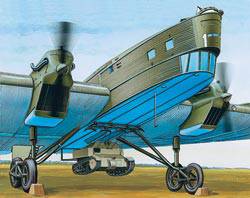 T-27 wedge on a PD-T hanger under the TB-3 bomber
T-27 wedge on a PD-T hanger under the TB-3 bomber Flying on the platform
This issue was dealt with by the Air Force Special Design Office (Oskonbyuro) under the direction of P.I. Grokhovsky. In 1932, the PD-O parachute system was successfully tested there to reset the 76-mm mountain cannon arr. 1909 of the city. The gun was suspended between the posts of the TB-1 bomber chassis, and the parachute in the cylinder-conical box was mounted on the bomb holder under the fuselage. In the same year, the Air Force adopted the G-9 system: two Harley-Davidson motorcycles were hung on bomb racks under the wings of the P-5 biplane. Each motorcycle was enclosed in a special frame and equipped with two parachutes, which were tied through a hole in the center of the first dome and opened one after the other. Later, Oskonbyuro made a PD-M2 suspension for two Harleys with wheelchairs. She could carry a TB-1 bomber under the fuselage. Based on the same carrier, a PD-A parachute suspension was designed for the Ford-A passenger car (or GAZ-A). However, at Oskonbyuro the car was altered into a pickup truck, in the back of which a dynamo-jet (recoilless) DRP gun was mounted. In addition, the car received reinforced springs, wheel covers and fairing in front of the radiator. From motorcycles and cars switched to armored vehicles.
In the same 1932 year, without departing from the tempo, we fabricated a sample of the G-43 (PD-T) system for parachuting the English "Wedge-Lloyd" wrist-cloth or its Soviet version T-27. Since the mass of tankettes significantly exceeded the maximum permissible load of the TB-1 bomber, it was lightened to kilogram 334, removing all that is possible and even draining water from the cooling system. The plane also had to facilitate. In particular, they dismantled one of the rear turrets and all the machine guns, significantly reduced the fuel stock. In December 1932, the PD-T system was tested at the Air Force Research Institute. It became the prototype of a large number of such devices intended for the landing of light tanks, armored vehicles and cars.
In 1935, the PG-12 (for the landing assault) and PG-12P (for parachute dropping) were put into service. For the first version, a truss loading platform was attached, which made it possible to transport and parachute cars, armored vehicles, light tanks and artillery pieces weighing up to 3 tons. For example, a pickup truck (based on GAZ-A or M-1), a GAZ-AA lorry (with a cut-off upper part of the cabin) or four guns at the same time — two 76-mm regimental and two 45-mm anti-tank with front. The platform was suitable for the transport of a small amphibious tank T-37А and a light armored car D-12.
For the first time, the delivery of T-37A tanks by air by bombers TB-3 was demonstrated during the so-called Great Kiev maneuvers, which took place in September 1935. When transporting the tank by air, its crew was in the plane. After landing, the bomber navigator, simply by pressing a special pen, separated the tank from the aircraft, the tank crews took their places and the vehicle was ready for battle.
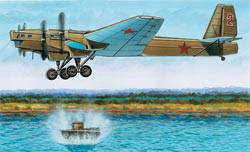 Discharge of small floating T-37A. Moscow, Bear Lake, October 1936 of the year
Discharge of small floating T-37A. Moscow, Bear Lake, October 1936 of the year Dangerous landing
However, simply “landing” a tank on the ground is not a problem, the problem will be ahead. In October, the 1936 of the Year at the Bear Lakes near Moscow tested a system for dumping tanks into the water. The design of the TVD-2 suspension and the dumping mechanism was carried out in the design and engineering sector of the research and testing department of the Stalin Military Academy of Mechanization and Motorization under the guidance of the military engineer of the 3 rank J.I. Kotin. The T-37A tank was dropped on the lake from a height of 5 — 6 meters at a speed of 160 km / h. After touching the water, the car jumped over the surface of 25 — 30 meters like a pebble, launched on the water surface with a strong hand.
To protect the tank when hitting the water under its bottom fastened special shock absorbing devices. All of them were extremely simple: an iron-lined wooden beam under the bottom of the tank, a steel sheet (between it and the bottom paved spruce branches) and, finally, just a bunch of fir branches. In the first case, the amphibian washed the bottom and vomited part of the rivets. About 20 minutes she kept afloat, and then sank. In the second and third - the tanks began to sink immediately due to cracks in the hull. The idea was considered hopeless, and work on the TVD-2 stopped.
In December 1938, the Moscow plant "Lift" produced the first batch of new suspensions DPT-2. It was easier to mount such a suspension than PG-12, and it took less time to load the equipment. The load range includes the T-38 tank, BA-20 and FAI armored cars, the Komsomolets armored tracked tractor, and the 5AK mobile radio station on the chassis of the GAZ-A pickup truck. The new suspension made it possible to transport a GAZ-AA truck with a conventional cab and even a three-axle GAZ-AAA by air. In 1939, DPT-2 was adopted.
Meanwhile, the possibilities of transport aviation did not correspond to the rapid growth of the airborne troops. The main rate was still on airplanes TB-3, which by that time was clearly outdated. However, there was simply nothing else. Therefore, in the last major pre-war maneuvers of the airborne troops in August 1940, all the same TB-3 participated. The exercise imitated the seizure of the Migalovo airfield near Kalinin (now Tver). First, the 26 bombers of the TB-3 landed a battalion of paratroopers, then they dropped cargo from three P-5. One TB-3 parachuted two motorcycles. Paratroopers "captured" the airfield and began to receive the landing wings "Tank Wings" designed by O.K. Antonov. 1942 year Project of a flying tank designed by A.N. Raphaelian. 1933 year English heavy airborne glider "Hamilcar" landing. Nine T-37A tanks and batteries - 76- and 45-mm guns were unloaded from the aircraft. Everything went well, but the backlog of our transport aircraft led to the fact that, despite the accumulated experience, during the Great Patriotic War, the airborne troops of the Red Army rarely landed, as well as heavy weapons were thrown very rarely by air.
The project of a flying tank designed by A.N. Raphaelian. 1933 year
Own wings
However, experimentally, various attempts of this kind have been made. In particular, the idea of a "flying" tank, Christie, was not left without attention. Thus, 19 January 1933, the design bureau under the direction of A.N. The Raphaelian was given an assignment to develop a project for a full-fledged flying tank. A month later, the project was ready. It consisted in the suspension of a wheeled-tracked tank BT to a non-powered aircraft. The propeller was driven by mechanical transmission from the engine of the tank. After landing, the detachment of the tank from the aircraft took place without the crew leaving the car. In addition to this project, two more variants of a flying tank were proposed: one by TsAGI engineers A.L. Dobrovolsky and P.D. Samsonov, the second - N.I. Kamov. The first project differed from the design of the Raphaelan by the presence of hydromechanical power transfer to the screw, the Kamov project was actually an autogyro tank. The wooden model, made by the first project, 31 March, March 1933, was blown in the wind tunnel TsAGI.
The tank itself was somewhat different from the serial BT-2 body shape and composition of weapons. On the tank it was planned to install an 20-mm automatic cannon with 500 rounds of ammunition or a DT machine gun. The crew of the car - two people. Armor protection - anti-bullet, from 4 to 8 millimeters. The hull envisaged the use of light alloys and special steels. In the aft part of the machine was installed 12-cylinder carburetor engine M-17 power 650 l. s., which provided the tank with air speed up to 160 km / h.
By the end of May 1933, after analyzing the project carried out by the Air Force Institute, it became finally clear that the engine power would not be enough for the tank to fly at any acceptable level. In addition, the training of tank pilots would be a serious problem. Therefore, further work on this project was stopped.
However, at the beginning of World War II, this idea resurfaced. In the autumn of 1941, the designer of light aviation, OK Antonov proposed to build a simplified towed airframe of a single use, for the fuselage of which the hull of the T-60 tank would be used, and its running gear as the chassis. As conceived by the designer, the airframe was intended for the transfer of light tanks as part of assault forces to the rear of the enemy, as well as for supplying large partisan detachments with them. It was assumed that such a combined glider could be towed by a TB-3 or DB-ZF bomber to its destination, and after dropping the towing rope he would sit down on a platform of limited size, drop wings with a tail and go into action.
The task for a similar aircraft, which had no analogues in stories, Antonov received at the end of 1941 of the year. The car was designed in just two weeks and by the summer of 1942, it was built at a glider plant in Tyumen. It was named CT (“Wings of the Tank”), and was also designated with the indices А-Т, АТ-1 or the glider A-40.
Airframe "Wings of the tank" design OK Antonov. 1942 year
Wings with a span of 18 meters and two-tailing tail were made according to a biplane scheme to reduce the size of the airframe. Its length was only 12,06 meter. The cable control was brought to the place of the tank mechanic-driver, having additionally equipped it with side and rear-view mirrors. The car itself was extremely eased (up to the mass of 5800 kilograms), removing armament, ammunition, headlights, wings and draining almost all the fuel. The flight mass of the tank glider was 7804 kilogram.
The only test flight of the CT glider took place in the fall of 1942. An airplane as part of the TB-3 tug plane (commander P. Yeremeyev) and a KT glider (glider pilot, also a driver-mechanic - test pilot SN Anokhin) successfully took off. However, due to the large aerodynamic drag of the airframe, towing was carried out at close to the maximum engine power with a speed of 130 km / h. Despite this, the speed of lifting the aeropod proved insufficient, and it barely reached the height of 40 meters. The attempt to increase the speed to 140 km / h did not give a positive result, since at the same time the aero-train started to decrease with the vertical speed 0,5 m / s.
In addition, the water temperature in the engine cooling system began to rise, which could lead to their overheating. Glider had to unhook in an emergency order. Incidentally, he surprisingly successfully sat on a ground field in the vicinity of the Ramenskoye airfield, causing a serious panic among the anti-aircraft gunners and the aerodrome service battalion command that was not warned about what was happening. Dropping the wings, the T-60 returned safely to Monino base on its own.
There is, however, a slightly different description of this landing. They said that, after landing, Anokhin launched the engine of the tank and, without dropping the wings, slowly but surely moved to the command post of the airfield. Without being notified of the emergency landing of an unusual device, the head of the airfield's flights for combat alarm raised the calculation of the anti-aircraft battery. When the test pilot got out of the car, he was detained by the Red Army men. The incident was settled with the arrival of the rescue team of the Flight Test Institute (LII). The tank was driven under its own power to the village of Stakhanovo (now the city of Zhukovsky) to the LII airfield.
Due to the lack of other suitable for this purpose bombers, the best of which would be Pe-8, this interesting work did not continue. Long-range aviation had only about 40 of such machines, and nobody would have allowed them to be used as towing vehicles. Nevertheless, the test flight showed that the idea of a flying light tank is quite feasible.
Another attempt to create such a device was undertaken by the Japanese. In 1945, they built the layout of the Ku-Ro tank glider. He was a very narrow (in the full sense of the word) machine. The crew was in tandem: a driver (he is a pilot) in the wheelhouse, the commander behind him in a single tower. The sides of the tank were attached to the bearing plane, and the rear - with a single-fin tail. In the metal, this tank was not built.
The project of the suspension of the "flying" tank Christie M.1933 under the plane. Beginning of 1930's
Heavyweight gliders
As for the other countries participating in the Second World War, they focused on creating classic gliders and transport aircraft capable of transporting armored vehicles. For example, in Germany, on the basis of the heavy airframe Me 321, the six-engine military transport aircraft Me 323 “Giant” was created. Large and low-speed machines of this type were used mainly in the delivery of goods for the army “Africa” in the autumn of 1942 — in the spring of 1943. "Giants" began to carry in Tunisia, not only the usual cargo transporters (fuel, spare parts, food, ammunition), but also light armored vehicles, as well as various artillery systems, including 150-mm howitzers. Back delivered empty fuel barrels, spent cartridges and wounded. As a rule, the planes flew low, singly or in small groups. For example, the crew of Lieutenant E. Peter 26 in November 1942 of the year transported the Marder 323-ton self-propelled gun to Me 11D from Naples to Bizerte. The flight took almost two hours. Unloading, and then, taking on board the 4 tons of empty barrels, the plane headed back. However, the "giants" did not receive widespread use in the Luftwaffe, mainly because of their large size and low speed. The armored vehicles did not enter into service with the German airborne troops. Except, of course, in cases where the latter were used as ordinary infantry. The situation was different for the Western allies.
The creation of airborne troops in the UK began under the influence of successful operations of the German paratroopers in Norway and the Netherlands. For use as an airborne tank was elected "Tetrarch." For its transportation company General Aircraft Ltd. created the Hamilcar 16-ton glider, which had a folding nose and a ramp. The crews were inside the tanks (in each glider there was one tank), and after landing the combat vehicles immediately left the gliders. The Hamilcars were usually towed by Halifax bombers.
The largest combat episode in the fate of "Tetrarch" refers to the day "D" - the day of the Allied landings in Normandy 6 June 1944 of the year. They were part of the 6 th reconnaissance airborne regiment of the 6 British Airborne Division. Eight tanks were included in the second wave of the assault and were to attack the bridge over the River Orn. During the flight over the English Channel, the nose of one of the gliders opened and the tank and the crew fell into the water, so that only seven combat vehicles reached the destination. Most of the tanks, after landing, entangled their tracks in parachutes scattered across the ground and did not participate in the battle (on the night of 6 June 1944, Normandy landed about 12 000 parachutists, so there were plenty of parachutes on the ground). Eight more tanks landed from the sea. Soon, almost all the Tetrarch tanks, which had shown low efficiency in Normandy, were replaced in the 6 airborne division by the Cromwell medium tanks.
English heavy landing glider "Hamilcar"
Flying without a tower
In February, 1941, the Americans also began to deploy their own airborne troops. To provide its paratroopers with support for armored vehicles, it was decided to develop a light tank weighing no more than 7,5 tons that could be transported by air. General Motors Corporation, renowned designer J.W. Christie and Marmon Herrington were invited to participate in the competition. The project of the latter seemed the most appropriate, and in May 1941 of the year she was ordered a prototype of such a tank. At the same time, the development of an aircraft capable of taking on this combat vehicle began.
The first prototype T9 had a mass of 8 tons, which, however, did not bother the leadership of the air corps of the US Army (aviation in the United States became an independent branch of the military much later), as well as the British who became interested in the American project. Fixing knots allowed to hang up the tank to the C-54 transport plane, however, it was necessary to remove the turret from the tank and load it into the plane. In April 1942 of the 500 advanced tanks T9EX1 were ordered, although their tests had not even begun. Because of the various problems that arose during the production process and the endless changes that were made to the initial design, only 1900 were made from the planned 830 machines, after which production was discontinued. The army was not satisfied with the design of the tank. Recent tests conducted in September 1943 of the year showed that the tank is unreliable, has limited mobility, is not sufficiently armed and armored. The military drafted with standardization (that is, the adoption of weapons), and only in August 1944 of the year ТХNUMXЕ9 received the army designation М1. However, both in the American and in the English army this machine was already well known under the name "Locust" ("Locust").
In August, the 1943-i airborne tank company was formed in Fort Knox 151, and in December of the same year the 28-i airborne tank battalion followed. However, the euphoria that accompanied the formation of the first tank units of the airborne troops quickly passed. The military was disappointed in Locust. The latter, being a tank, by definition, had to combine high firepower, reliable armor protection and mobility. In practice, most often it turns out that the insufficiency of one is compensated by an excess of the other. The trouble was that Locust was deprived of these three important qualities. Since the Americans failed to build a plane or a glider capable of transporting Locust without first dismantling the turret, the small weight and dimensions of the tank ceased to be its advantages. As for security, the armor of the combat vehicle was so thin that it made its way even with armor-piercing bullets of the 12,7 caliber of a millimeter. And finally, for the 1944 of the year, the engine power of the tank was too small, and its 37-mm gun could not withstand any criticism at all.
Therefore, as part of the US Army, Locusta did not participate in the hostilities of World War II, and after it was over, they were quickly written off. The only combat episode with their participation is associated with the British army. The British were lend-lease 260 tanks of this type. However, only 6 vehicles were included in the 17 airborne tank reconnaissance regiment. By March, the 1944 of the 38 heavy airplanes "Hamilcar", intended for the transport of tanks 6-th regiment, 23 were adapted to accommodate in them "Locust". The combat debut of these tanks took place on 24 in March 1945 of the year when the Rhine was forced. A half-horse-ride — eight cars — was dropped by the Hamilcar gliders on the right bank of the river. In the battle, however, not all took part. One tank supported paratroopers from the 17 of the American Airborne Division, mistakenly slipping through their landing zone. Another four "Locust" acted in conjunction with the infantry of the 12 th battalion of the Devonshire Regiment and the paratroopers of the 6 British Airborne Division. No more detailed information about this episode in the foreign press, primarily English, is given.
Parachute Tanks
Based on the experience of the Second World War, the West concluded that it would not be expedient to further deploy airborne troops. Everywhere they were either significantly reduced, or, as in the United States, retained the same number as in the war years. The situation was different in the USSR - the mass deployment of the airborne troops began here, and intensive development of military equipment for them and their delivery systems began.
The release of parachute combat vehicles has not been discussed yet - there were neither appropriate aircraft, nor landing systems. Delivery of equipment could be carried out only by gliders, the design of which was carried out in parallel. In the late 1940-x - the beginning of the 1950-ies in the USSR, several samples of light airborne self-propelled guns were created. The most successful were ASU-76 and ASU-57. However, over the first year in August 1953, work was stopped due to the unreadiness of the Il-32 glider and the towing vehicle. The second was put into service in 1951 year and launched into the series. The anti-tank company of each parachute regiment consisted of nine units. For the landing of ASU-57 initially used containers P-90 (two such containers were hung under the wings of a Tu-4 bomber) and gliders Yak-14. After the appearance of the An-8 and An-12 aircraft in military transport aviation, the multi-dome parachute systems and the parachute platforms PP-57-128 began to be used for the landing of the ACS-5000. Airborne For a long time and was armed with a heavier and more powerful air transportable ACS ACS-85. According to the state in each airborne division there was one division from 31 ASU-85. They landed mainly landing method, at least - with the help of a parachute platform P-16.
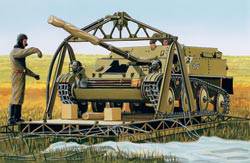 Resetting the Sheridan tank from the C-130 transport aircraft using the LAPES exhaust system
Resetting the Sheridan tank from the C-130 transport aircraft using the LAPES exhaust system As for the other models of armored vehicles, at the end of the 1950-s, armored reconnaissance vehicles of the BRDM, and later of the BRDM-2, as well as self-propelled anti-tank missile systems, arrived at the airborne forces. All of these combat vehicles landed landing method.
In the middle of the 1950-s, the Americans decided to acquire a lightweight airborne tank. The reason for the development was the experience of the war in Korea, which revealed the urgent need to create forces of rapid deployment. The formation of such forces in the United States stretched for decades, but the process was launched just then. However, the development of such a tank stretched over 10 over the years. The machine M551 "General Sheridan" was adopted only in 1966 year.
Aluminum alloy was widely used in the hull design of the 16-ton tank. The main armament, the 152-mm cannon / launcher, was installed in the steel turret, which, in addition to conventional artillery shots, could fire MGM51A Shilleyla anti-tank guided missiles (ATGM).
As part of the armored cavalry units of the US Army, these tanks fought in Vietnam, where they were not particularly popular with the crews, since they were too vulnerable. As for the airborne troops, strictly speaking, the tanks did not drop parachutes. For the landing, a special exhaust system LAPES was used. From a small C-130 flying at low speed with parachutes, a platform with the Sheridan fixed on it was being pulled. The impact energy of the ground was extinguished by the depreciation system of the platform. The crew of the tank landed separately from his combat vehicle.
In 1978, the massive withdrawal of Sheridan from the ground forces began. They remained only in the 82 and 101 airborne divisions, since there was no other tank that could be parachuted in the United States.
Perhaps, the work of the Americans on Sheridan to some extent caused the deployment of similar work in the USSR. In the middle of the 1970-ies, marines and airborne troops expressed their interest in a well-armed and adequately protected floating combat vehicle. In this case, the requirement for aero-transportability was added to the requirement for buoyancy. Apparently, the airborne troops, dynamically developing in those years both quantitatively and qualitatively, became the main developer of tactical and technical requirements.
In accordance with them, in the 1975, at the Volgograd Tractor Plant under the direction of the chief designer A.V. Shabalina designed and manufactured a prototype of a light airborne amphibious tank "object 934". Its welded hull and tower were made of aluminum alloy, which provided protection against armor-piercing shells of a caliber 23 millimeter at a distance of 500 meters. In the frontal part of the tower were installed steel plates. Combat weight was 17,5 tons, the crew had three people.
The tower housed a 100-2 lightweight 48-mm rifled cannon stabilized in two planes of guidance, equipped with a two-chamber muzzle brake, an ejection device for purging the barrel and a loading mechanism. The ammunition consisted of 40 artillery shots (19 of them in the loading mechanism) and 2000 ammunition for the twin PKT machine gun. A portable Strela-3 air defense missile system and four missiles were mounted inside the tank. The four-stroke multi-fuel diesel 2В-06 with turbocharging and air cooling in the heat exchanger was installed in the engine compartment. Engine power - 400 l. with. Transmission - manual, with a two-line mechanism for gears and turns. Pneumo-hydraulic suspension provided variable ground clearance ranging from 120 to 530 millimeters. A water jet was used to move through the water.
The installation of a powerful engine (specific power - 22,8 hp per ton) and modern transmission provided the maximum speed of land on land 70 km / h, and on water - 10 km / h. Cruising when driving overland reached 600 kilometers. The design of the tank was adapted to airborne parachuting from the An-22 and Il-76 aircraft.
In parallel with the “934 object” on the same technical task in 1975, at Kurganmashzavod under the direction of the chief designer A.A. Blagonravov designed and manufactured a prototype of the 685 object light amphibious assault tank. The 16,5 tonne tank had a steel welded hull and a titanium alloy tower. In terms of armor protection and weaponry, it was comparable to the “934 object”. Characteristics of mobility were also similar to the Volgograd machine.
Both tanks were tested, but they were not accepted for service and were not launched into mass production. They were, in fact, representatives of the group of combat vehicles for the so-called rapid reaction forces and, as such, anticipated the appearance in the West of such tanks as the American M8 and Stingray. But the latter, with the same mass and similar weapons as Soviet machines, cannot swim.
Illustrations by Mikhail Dmitriev
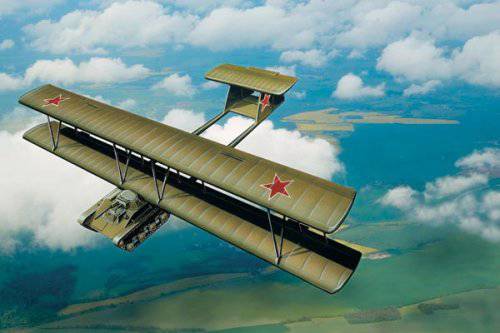
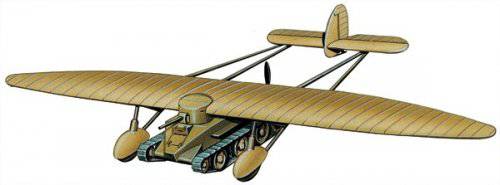
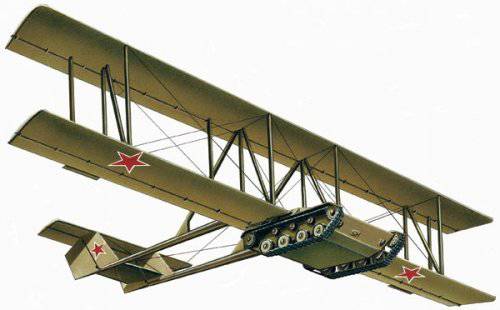

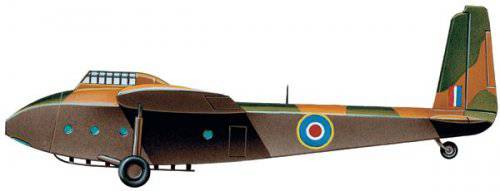
Information